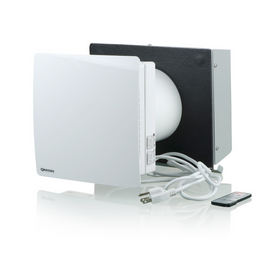- Home

Essential Home Features
While the solar PV system, the energy-efficient design, and the impressive net-positive energy status of this home are certainly the focal point for the attention it has garnered, the home also includes several other impressive and sustainable features.

The home integrates LED lighting throughout every room, though the artificial lighting requirements are minimized through a design strategy that maximizes natural light. Despite the home's unideal east/west orientation, which tends to cause problems with passive solar heat gain, the designers and builders were able to maximize natural daylighting through the thoughtful placement of argon-filled Energy Star rated windows and a central skylight. The selection of the windows was primarily based on the specific solar heat gain coefficients and solar shading coefficients to help limit excessive heat gain that is common to homes with this glazing orientation.

To reduce the cooling load that would be needed in the summertime due to the large amount of natural light and heat that floods into the home, a natural ventilation system was integrated through venting hot air out of the third-floor windows in the penthouse while drawing in cooler air from windows in the basement and the first floor. An air-to-air heat exchanger also allows for fresh air intake.
This net-positive energy home also has permeable paving throughout the yard. While yard and garden space in downtown Chicago is a rarity, the homeowners deliberately designed a slightly smaller home to free up a bit of green space around their home. They planted most of their landscape with vegetation with low water requirements, virtually eliminating extra irrigation. The planters on the green roof allow for further foliage and add a biophilic dimension to the home.
Other sustainable features include:
- Water Sense™ plumbing fixtures
- Cement fiberboard rain screen siding system
- Energy Star appliances
- Outside combustion air for the gas fireplace
- Low- and no-VOC paints and finishes

A Connection to Place
We don’t usually think of homes in metropolitan areas having much of a connection to the regions where they are located. The urban landscape doesn’t offer an abundance of locally available raw materials for home construction as is possible in more rural and suburban areas. However, this net-positive energy home made a serious effort to utilize locally-sourced wood materials for the home construction.
Tobias Roberts
Tobias runs an agroecology farm and a natural building collective in the mountains of El Salvador. He specializes in earthen construction methods and uses permaculture design methods to integrate structures into the sustainability of the landscape.













